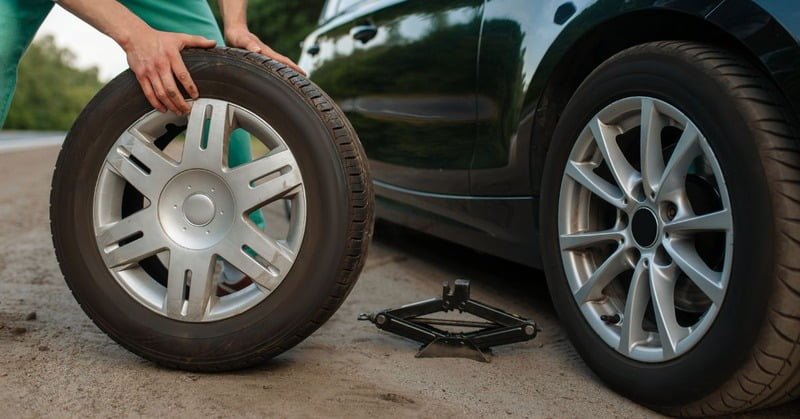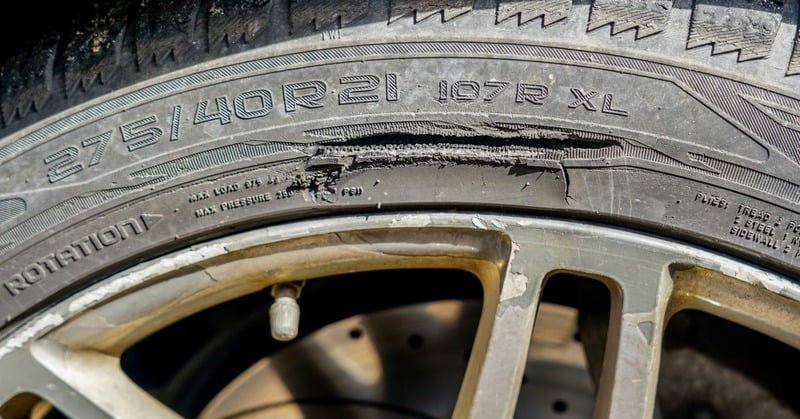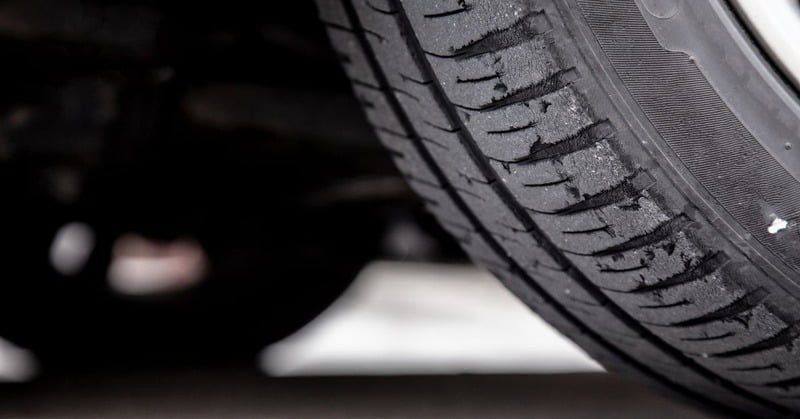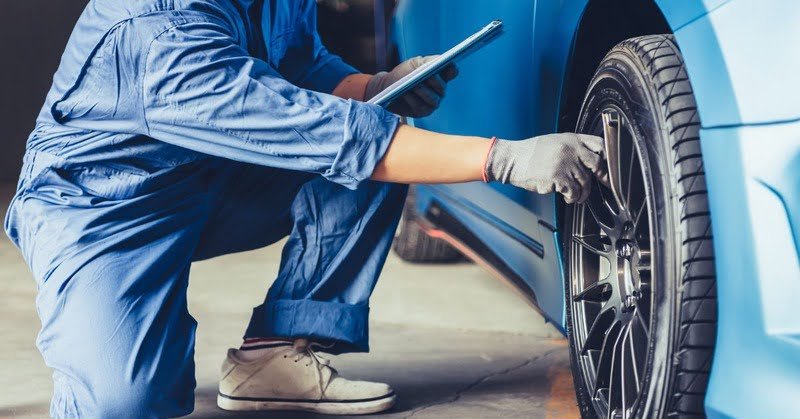Blog
Tire Damage from Hitting a Curb: 4 Things You Should Check First
We’ve all been there: that heart-dropping moment when you misjudge a turn and hear the unsettling thud of your tire against a rolled curb, potentially leading to tire damage from hitting a curb.
First and foremost, take a deep breath. It’s okay, and you’re not alone in this.
Many of us, in a split-second lapse of judgment or unforeseen circumstances, have felt that gut-wrenching crunch of tire meeting curb.
We understand the flood of questions and concerns that might be racing through your mind right now. “How bad is the damage?” “Is it safe to drive?” “What should I do next?”.
The immediate rush of worry is natural, and it’s perfectly understandable.
Below are the things you need to know if you’ve hit your tire on a curb. From assessing the potential damage to finding the best way forward, Smooth Curb has got you covered.
Table of Contents
Does Hitting A Curb Damage Your Tires?
Yes. Hitting a curb can certainly damage your tires. If you’re reading this after such an incident, you’re likely already suspecting as much.
However, the extent and type of damage can vary based on several factors, such as the speed of the impact and the angle at which your tire meets the curb. It’s not just about visible scratches or dents; internal damages might be lurking beneath the surface.
In the following section, we’ll talk about the potential damages to help you understand exactly what might have happened and what you should be looking out for.
ALSO CHECK: What Steps Should I Take After My Car’s Front Side Struck a Curb?
What Damages Can Your Tire Have If You Hit A Curb?

Let’s dissect the potential damages so you have a clearer picture of the road ahead.
1. Sidewall Damage
The most prevalent aftermath of a curb collision is sidewall damage.
This area of your tire bears the brunt during such impacts. You might observe visible cuts, scrapes, or bulges on the sidewall.
Bulges: Bulges, in particular, are a significant concern. They indicate a breach in the tire’s internal structure where the trapped air pushes against the flexible rubber, causing a protrusion. Such bulges can lead to dangerous blowouts, especially at high speeds. If you spot any, it’s a sign that a tire replacement is imminent.
Punctures and Cuts: A tire that has been cut on its sidewall due to hitting a curb.

Though less common, a sharp or rugged curb can inflict punctures or significant cuts, especially if the hit was at a considerable speed. Such damages are often beyond repair if they exceed a certain size, necessitating a tire replacement.
2. Bead Damage
The bead ensures the tire seals snugly against the wheel. A hard curb strike can jeopardize this, potentially leading to gradual air loss. In extreme cases, a compromised bead might even cause the tire to detach from the rim, an exceptionally hazardous scenario at high velocities. Always inspect the bead area post-impact to ensure there’s no evident damage.
3. Internal Structural Damage
Tires, although seemingly straightforward, are complex. Beyond the rubber, you see, there’s a labyrinth of steel belts, radial plies, and protective layers. A strong enough hit can damage these inner layers, weakening the tire’s structural integrity. Over time, this can lead to tire separation, resulting in potential air loss and blowouts. Such damages are, unfortunately, irreparable, warranting a tire change.
4. Uneven or Premature Wear

Consistent, low-speed curb impacts, like those during parking, might not cause immediately noticeable damage. However, these minor damages can lead to uneven tire wear, ultimately shortening its lifespan. While these effects are subtle, they cumulatively impact your tire’s performance and safety in the long run.
Can You Still Use Your Tire Even After Getting Hit on a Curb?

The short answer is: it depends.
Every curb collision is unique. Factors like the speed of the impact, the angle at which you hit, the sharpness of the curb, and the existing wear of the tire all play significant roles.
In some cases, if the collision was minor and the tire shows no visible signs of damage, it’s likely still usable. On the other hand, clear damages such as deep cuts, sidewall bulges, or punctures indicate a need for immediate replacement.
What Can You Do Once Your Tire Has Been Damaged From Hitting A Curb?
The short answer is: It’s always recommended to have a professional assess your tire after a collision to ensure your safety. They’ll be able to provide a more definitive answer based on the actual condition of the tire.
But there are also other things that you should keep in mind and do if you’re considering having your tires checked.
Let’s go through all the possible things you can do, bit by bit:
Professional Tire Inspection

First and foremost, if you suspect damage, head to a professional tire shop or mechanic for a comprehensive inspection. They possess the expertise to gauge the severity of the damage and will offer sound advice on whether a repair or replacement is necessary. Remember, it’s not just about visible damages; internal structural issues could pose potential risks down the road.
Wheel Alignment Check
Hitting a curb doesn’t only affect the tires. The impact can throw off your vehicle’s wheel alignment. Misalignment can lead to uneven tire wear, reduced fuel efficiency, and a less-than-smooth ride. A quick trip to the garage can help realign the wheels, ensuring a longer tire lifespan and optimal vehicle performance.
Suspension Examination

The car’s suspension system can also bear the brunt of a curb impact. Components like the control arms or tie rods could be compromised. A professional will be able to spot and rectify any issues, ensuring that your drive remains comfortable and safe.
Regular Vehicle Maintenance
It’s always a good practice to maintain regular check-ups for your vehicle. This ensures that any minor damages or wear and tear – from curbs or other factors – are detected early on, preventing larger issues and expenses in the future.
Consider Curb Ramps

To avoid similar incidents in the future, especially in places you frequent, like home driveways, consider investing in a curb ramp. Curb ramps act as a gentle bridge between the road and the curb, ensuring a smoother and safer transition. Not only can this simple addition save your tires from potential car damage, but it also protects the undercarriage of your vehicle.
And if you’re wondering where to find a quality curb ramp, look no further.
Our Smooth Curb – Driveway Curb Ramp is specifically designed to cushion that transition, reducing the chances of tire and vehicle damage. Durable, easy to install, and effective, it’s the perfect safeguard against unfriendly curbs.
What Other Vehicle Components Can Be Affected When You Hit a Curb Besides Tire Damage?
When your vehicle collides with a curb, it’s not just your tires that are at risk. Several critical components can damage your vehicle’s overall performance and safety.
Let’s explore these potential complications:
- Steering Wheel Misalignment: The impact of hitting a curb can lead to the misalignment of your steering wheel. As a result, you may experience less responsive or off-centered steering, compromising your control over the vehicle.
- Damaged Steering Knuckle: The steering knuckle, which plays a crucial role in connecting the wheel, suspension, and steering parts, can sustain severe damage. This damage may cause erratic steering behavior and necessitate complex repairs to restore proper functionality.
- Steering Column Stress: The force absorbed by the steering column during the impact can affect its alignment or, in severe cases, its structural integrity, further complicating steering issues.
- Vehicle’s Suspension: A hard hit can jolt the vehicle’s suspension system, leading to misalignment or damage to components like shocks and struts. This can reduce ride comfort and compromise vehicle stability.
- Oil Pan Damage: Located at the bottom of the engine, the oil pan is vulnerable to curb strikes, especially in lower vehicles. Damage to the oil pan can result in oil leaks, endangering your engine’s health and longevity.
- Exhaust System Compromise: The vehicle’s exhaust system is at risk of being directly hit or jostled during the impact. This can lead to potential leaks or blockages, affecting engine performance and emissions.
- Fuel System and Transmission Risks: The fuel lines may be at risk of a severe curb impact, potentially leading to hazardous fuel leaks that can also detrimentally affect vehicle performance. For vehicles with low clearance, the entire transmission system could be impacted, potentially causing significant damage, such as the need for cracked case housing repair or addressing misalignment.
- Catalytic Converters: Positioned under the vehicle, catalytic converters can sustain damage in curb incidents. This damage can affect emission control systems and possibly trigger engine warning lights, necessitating repairs to maintain environmental compliance and engine performance.
Final Thoughts
Driving can sometimes throw unexpected challenges our way, and that sudden impact with a curb can truly jolt us.
But remember, while the immediate reaction might be one of panic or frustration, you’re equipped now with the knowledge to address such situations. Understanding the potential damages and the subsequent steps to take ensures that you’re not caught off guard.
Tires, as vital as they are, can be checked, repaired, or replaced. The true value lies in ensuring safety, both for you and other road users.
While it’s essential to know how to respond to tire damage from a curb, it’s equally crucial to take preventive measures, like investing in quality curb ramps.
At Smooth Curb, we’re here to assist, guide, and provide solutions.
If you’re eager to learn more about what curbs can do to your car, don’t hesitate to check out our blog section. There, we cover everything you need to know about curbs, car damage, and everything in between.
This isn’t the end of the road. In fact, consider this a pit stop, offering actionable steps and effective solutions to get you back on track and cruising safely once more.
We hope we’ve provided the answers you were looking for, and we look forward to seeing you in our next post.
Related Questions
Got a few more questions about curbs causing damage to your tires? Maybe we’ve answered some of them below:
How much tire damage is acceptable?
While any tire damage isn’t ideal, minor abrasions or superficial marks often don’t affect the tire’s overall performance. However, any damage penetrating the tire’s outer layer, especially on the sidewall, is a cause for concern. It’s crucial to monitor even minor damages, as they can escalate over time. When in doubt, always consult a tire professional to assess the severity and guide on the appropriate course of action. Remember, safety first!
Can you drive with a damaged tire wall?
Driving with a damaged tire wall can be risky. The sidewall is a vital part of the tire, responsible for its structure and integrity. Damages like bulges or deep cuts compromise the tire’s safety, increasing the chances of blowouts. If you notice sidewall damage, especially post-curb collision, it’s advisable to avoid driving on that tire and seek immediate replacement or professional advice.
What damage can a tire not be repaired?
Tires with certain types of damage are often deemed beyond repair. This includes sidewall bulges, which signal internal structural harm, punctures or deep cuts on the sidewall, signs of internal damage such as tire separation, and notably large punctures, usually over ¼ inch in diameter. When encountering these damages, especially after incidents like striking a curb, it’s typically best to replace the tire. Always prioritize safety and seek expert advice when unsure.


